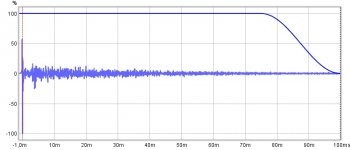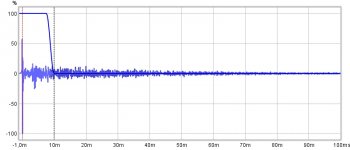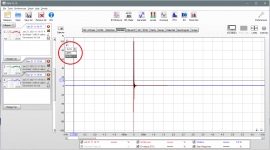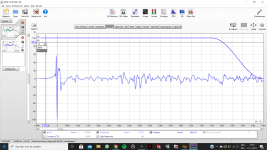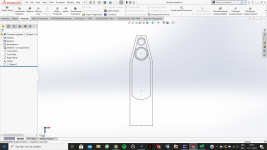The gating truncates the impulse response where the the room starts to ruin the response. But you have to APPLY it. Your impulse response is definitley not gated at all.
Edit: Just saw your response. There must be a function where you can set another cursor or line and subsequently showing only the part within those two marks.
Regards
Charles
Edit: Just saw your response. There must be a function where you can set another cursor or line and subsequently showing only the part within those two marks.
Regards
Charles
Last edited:
Try measure a raw driver by it self with no crossover, when you can handle that with confidence and with repeatable results you can then scale it up to multiways
There's absolutely no way I'm pulling my speaker appart so that's not gonna happen. But what progress am I supposed to make with that? I've absolutely not got a single what the measurments are doing and supposed to be doing anymore.
There's absolutely no way I'm pulling my speaker appart so that's not gonna happen. But what progress am I supposed to make with that? I've absolutely not got a single what the measurments are doing and supposed to be doing anymore.
You don't need to pull apart the speakers, with Hypex Fusionamps, just mute the channels that you don't want to measure.
active 3 way
Hi
Do you use digital DSP crossover or DSP and analog active crossover?
I find the sound warmer and more spatial with DSP and analog crossover.
Used the Najda, but now I prefer the Thel Audio analog crossover...
Cheers, Tojoko.
Hi
Do you use digital DSP crossover or DSP and analog active crossover?
I find the sound warmer and more spatial with DSP and analog crossover.
Used the Najda, but now I prefer the Thel Audio analog crossover...
Cheers, Tojoko.
made at listening position.
Sure, but measuring at final listening distance indoors for crossover design is impossible probably in 99.9 % cases. That is usually called as "in-room response".
So gated is way to go, but of course travel distance of reflections must be maximized to enable as long time window as possible.
There's absolutely no way I'm pulling my speaker appart so that's not gonna happen.
you do not have to, maybe you have a driver laying around that you can train on?
But what progress am I supposed to make with that?
you need to learn how to make measurements, start with the simple and go from there
I've got absolutely no clue how to get this to work anymore.
I think I'll move the speakers to my local high end shop and measure the speakers in their large listening space. This would have to be after a month though.
I think I'll move the speakers to my local high end shop and measure the speakers in their large listening space. This would have to be after a month though.
In REW, move your curser anywhere into the Impulse window. You will see a drop down box appear in the left upper corner. Select "% FS". See pic below.
Then read this paper by the late, great Jeff Bagby and then read it again and again until you fully understand it:
How to achieve accurate in-room quasi-anechoic free-field frequency response measurements down to 10Hz
Then read this paper by the late, great Jeff Bagby and then read it again and again until you fully understand it:
How to achieve accurate in-room quasi-anechoic free-field frequency response measurements down to 10Hz
Attachments
Why and what do you mean exactly? Distance of first reflection - distance from speaker to mic?
What does the gating doe exactly? Because the graphs look very weird.
"clean" direct signal is the same as the dirty reflected one, they both depart from the speaker at the same time, it is the same signal front. If your mic is one meter away, the direct signal arrives to the mic in about 3 milliseconds. Now the part of the signal that is going to cause the reflection has already travelled the same one meter, or three milliseconds, and is that much closer. So, subtract the speaker<>mic distance from the reflective path lenght. Hope it helps. You should spend some time on this to get your speaker right. It won't happen in one evening 🙂 Don't get frustrated, you can figure it out!
Then I still don't understand why I have to substract the speaker-mic distance.. I'm trying to filter out the first reflections. So then the gate must be set right befor the reflections arrive?
Even though the measurments I made I think weren't accurate at all. They different settings/measurment setups at least gave a similair impression that the treble was quite jagged. I will building a new pair of enclosures which will be finished (veneered and polished by Bush, dutch company who renovate, maintain and also refinish Riva's). I immediately changed the round top of the enclosure for a square top to hopefully achieve a flatter natural FR.
Even though the measurments I made I think weren't accurate at all. They different settings/measurment setups at least gave a similair impression that the treble was quite jagged. I will building a new pair of enclosures which will be finished (veneered and polished by Bush, dutch company who renovate, maintain and also refinish Riva's). I immediately changed the round top of the enclosure for a square top to hopefully achieve a flatter natural FR.
Attachments
3wayaddict, are you sure you don't have any effects running on your computer, settings in your volume control, plug-ins etc?
I'll read it.
After that you might be ready to jump directly from the last millennium to advanced and modern approach including off-axis to 180 deg, measured phase and possibly merging of simulated directivity at LF to measured directivity at HF in case measured directivity (at LF) is not reliable enough. All this to enable decent acoustical simulation to full space (in two planes) while crossover design.
Sounds pro, but shouldn't be impossible because almost uneducated country boy like me can do it.
About 3x3 m floor area is minimum, but 4x4 is adequate for sure. Room height ~3 m would be nice. We have 247 cm at home which is okay, but not optimal.
Don't get frustrated, you can figure it out!
Yeah I get dangerously frustrated real quick when things don't work as they should for no apparant reason or that I understand.
Hi,
I have my active speaker system. Which sounds exceptionally good. Though, with good recorded, non offensive music. The system is also extremely unforgiving. Any rock more aggressive than Alice In Chains - Unplugged with distorted guitars and other screaming and harsch chracteristics is unlistenable.
I know that no matter how warm you make it, a resolving, low distortion system will always make poorly recorded music sound bad. But I at least want to be able to listen to it without my ears bleeding.
The system is already guite on the warm side in terms of bass response, I like that. But I just can't get rid of that punishing harshness in the mid/high frequencies. I've tried rolling of the treble with a few dB, and a 2 dB dip between 1 and 2 kHz (BBC dip) but it doesn't cut it. In fact, There's not that big of an audible difference.
Does anyone know how to effectively make the system more forgiving?
You can slide this and listen where it pop out, it should be smoth over all register. You can then correct that bands eq:
Online Tone Generator - generate pure tones of any frequency
Only cut do not trim, golden rule 🙂
(The best way to find a warmth sound, is if one can find it by sliding the x-over point's and a b test)
Last edited:
sure, if you do this for clients and have a dead line you must consider your design done regardless if it sounds **** or not, but this is diy and we can do better then that
You could do, but nothing here shows that results are really better regardless of 10x longer design time. At least it's very difficult to believe because methods are really ancient and poor.
- Home
- Loudspeakers
- Multi-Way
- In need of warmth
